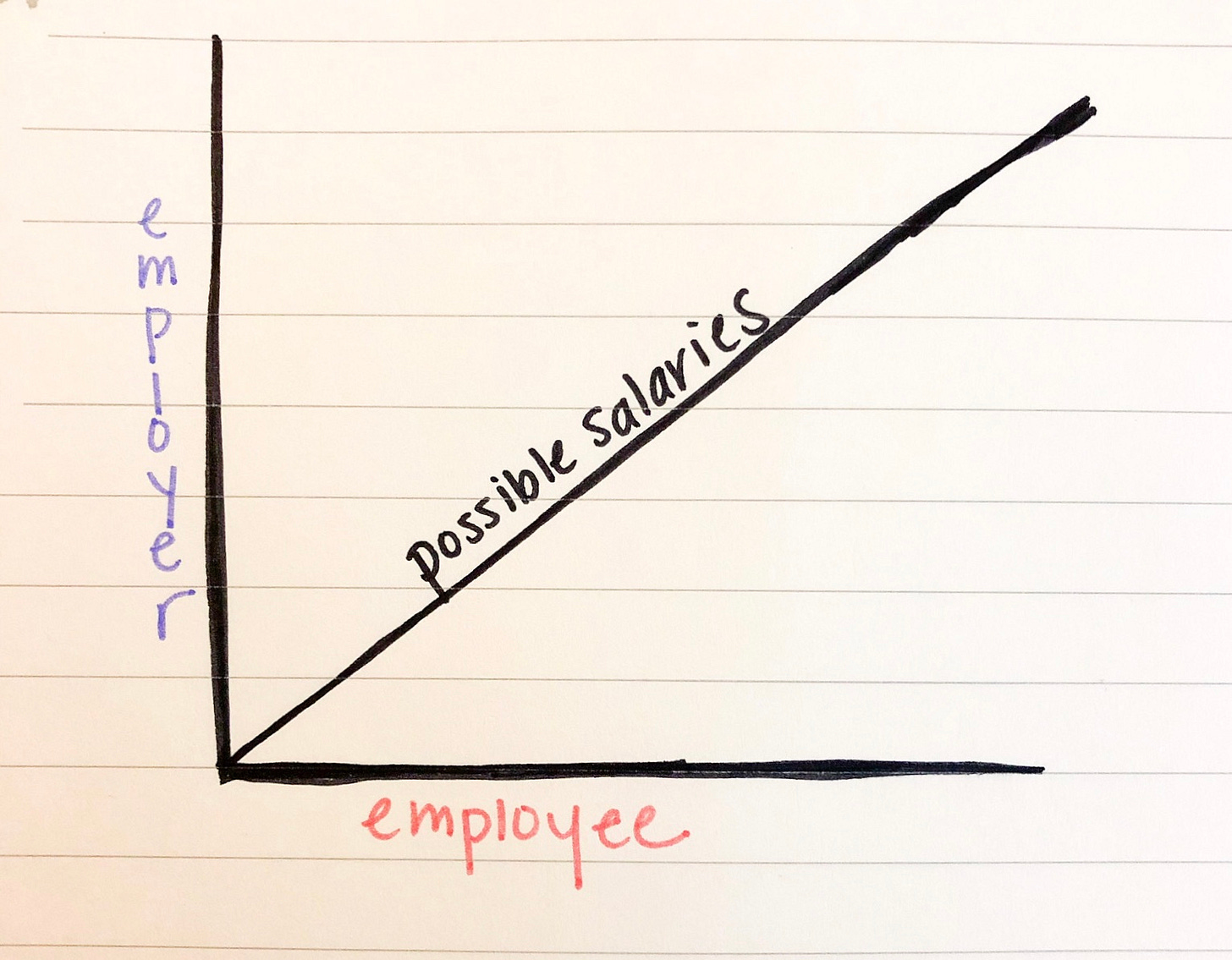If you’re not signed up for this newsletter, then welcome! I’m glad you found your way here! But like sign up, will ya? There’s a cute little button for you to do so.
And if you like this writing, consider donating to my Patreon. Any size pledge helps!

When we don’t include salary information, we disrespect—and drive out—members of our workforce.
Everyone has had this experience: you apply for a job, you send a resume, you meet with a manager, maybe you meet with a second person, perhaps you even do a shadow shift or a stage, and if things work out, you’re offered a job.
It’s usually then—and only then—employers will share how much they’re willing to pay you.
Most job descriptions don’t include salary information or wage ranges. Instead, most employers wait until a job has been offered before bringing up money. This is a huge mistake that cases the most talented and tenured members of any industry, let alone service professionals, to leave their jobs and abandon the trade altogether.
Like most shitty practices, there are a thousand reasons an employer might defend not publishing a salary range. There’s a pretty good list of terrible excuses here, including not wanting to alert competitors (like salaries are such a protected trade secret) and wanting to attract potential applicants based on skill rather than money.
But, as the above article argues, keeping wage information a secret until the end of the job application process usually boils down to one thing: employers are trying to pay the lowest amount of money for the most qualified applicants.
There’s no other reason to not set a salary range, especially because most businesses generally know how much money they have available for wages. There’s no way a person creating a job doesn’t have an idea of how much money is allocated for that job. And if you’re looking for a job at a huge company, it’s likely there’s a definitive salary range that had to be vetted and agreed upon by multiple people.
Just because you were offered $40k for a job doesn’t mean that $40k is what the company budgeted—nor does it represent what the job is worth.
Without salary ranges clearly stated in job descriptions, employers are able to select employees that both meet their qualifications and are the cheapest to invest in.
I found it easiest to understand when I drew it out. Imagine two potential employees going for the same job. Both have at least the minimum skills required for this position. The range of potential salaries is represented by the chart below:

The slope of the line represents possible salaries—it’s the dollar amount that the potential applicant and employer will agree upon.
Employee #1 is asked what they think the job should be paid, and they offer a certain amount. Obviously, they’re willing to be paid more, but the pink line and the shaded region to the right represent all the possible wages that person is willing to take:

The number that Employee #1 comes up with can come from anywhere. Imagine that moment when a potential employer asks you what you think a job is worth, or what you were paid at your last job (these sorts of questions are, in some states, illegal to ask). When that question is posed, the pink line is the number Employee #1 comes up with.
For the sake of this experiment, let’s say that Employee #1 would like to be paid $15 an hour. The employer already has some idea what they’re willing to pay and let’s say for this job it’s $16 an hour.
In this situation, Employee #1 is simultaneously within the pay range that the employer set out, but could have asked for more money. However, there’s no way for Employee #1 to know that. In the end, Employee #1 could have been paid a little more, but they’re still within the range of what an employer is willing to pay.
But let’s say there’s more than one potential employee. Employee #2, represented in green, says that they’d like to be paid $13 an hour:

However, the salary cap—of $16 an hour—still stands with the employer. That line is represented in dark purple below:

In this scenario, it’s pretty obvious that even though the employer has a budget to pay both the salary expectations of Employee #1 and #2, the employer will likely pick Employee #2. They can pay that person less and profit whatever they save.
These charts, I hope, are painfully obvious. You might even be wondering why I made them (tbh it was partially because I really wanted to draw something), but it’s important to see this displayed and understand that there’s a relationship between what employers choose to pay someone, separate from what they can afford, and what value employees set on themselves—and that relationship hinges on keeping wages a secret.
The above example is just one scenario but illustrates that, given a choice between two potential employees, an employer will pick the cheapest one—and this has nothing to do with how much is actually budgeted for that position. This is a problem for a few reasons.
One: It’s a literal race to the bottom. Instead of taking into account what an employer can afford, we’re encouraging people to devalue themselves to gain employment. If Employee #2 is willing to go lower than Employee #1, then Employee #1 might be incentivized to lower their salary requirements to remain competitive.
If this is happening on a large scale (spoiler alert: it is) then we’re systematically devaluing the labor of an entire workforce. If you wonder why service professionals are transient or quick to leave jobs, it’s because of this.
Two: Jobs are not inherently valuable. Even though capitalism teaches us that certain jobs are worth more than others, keeping wages a secret violates that. If we thought a job was worth X amount, we’d say it from the beginning. Because wages are often kept a secret until the end of the job application process, most employers are counting on paying employees the potentially lowest amount they can—instead of paying what a job is worth.
By keeping wages a secret, we sever the tie between value and worth. No one knows what their jobs are worth any more.
This is kind of a capitalism mind fuck. In capitalism, we’re taught that certain jobs are worth more than others, and that they should be paid an amount commensurate with the value we’ve assigned those roles. That’s why a doctor is paid more than a janitor (I want to be clear I don’t endorse this—I’m just using it as an example as to the mechanics of capitalism). But when we don’t reveal what a job is going to pay, we pretty much shit all over that premise, and somehow dive into a more unequal relationship between employer and employee than what capitalism has laid out. It’s weaponized misinformation.
Phew. That was a lot. But that’s not all!
Three. We’re wasting time and distorting reality. It’s so easy to hate your job. I could write a book about shitty jobs, and I imagine if you’re reading this you could too. So when we see a flashy job posting promising all the things we’re not getting in our current positions, many of us jump at the chance—only to find out after weeks of interviewing that this job is worse than the one we have.
When you don’t post salary ranges, you waste a lot of people’s time. There are folks who shouldn’t apply for the jobs you offer because they are too skilled or advanced in their careers to take them. If you’re offering a job with an entry-level salary, you have no business writing a job description that sounds amazing—and then falls flat when it comes to money.
And these promising job descriptions just warp our sense of what’s actually out there. You might be more inclined to stay in your current position if you knew the current job market was full of entry-level positions. Without salary ranges, we really don’t have a complete picture of what our job market looks like.
Four. We’re going to lose our workforce, and de-incentivize talent and growth. Pay secrecy is never good at any point in the employment process. From paying people different amounts for the same work to obscured timelines on raises and bonuses, policies that encourage secrecy breed mistrust and contempt.
People leave jobs when they feel like they can’t grow and they can’t trust their leaders. I know I’d be pissed if I was hired for a position and found out someone else was hired to work alongside me at a higher rate. If we’re doing the same job and have the same skills, then my company just told me I was worth less than my coworker. My work literally matters less, so why should I try hard?
Essentially, if we keep wages a secret, we discourage people from growing and getting better at their jobs. In fact, we’re encouraging them to perform poorly. Because pay secrecy divorces skill from worth, it becomes pointless to pursue further education or continued growth.
Posting salary ranges doesn’t mean everyone is going to demand the higher end of the range—what it does mean is that you’ll get an applicant pool that matches what you’re willing to offer. If you know that your salary range is low, you can be honest with potential applicants about their skills and where they’re at in their careers, and filter out potential employees who might feel undervalued at that range. If your salary range is high, you can attract the most talented members of your trade. If someone comes along who is a great fit but doesn’t totally match the skills you need, you can talk about a lower salary range and provide tools and goals to get them into a higher bracket.
There are so many healthy—and necessary—conversations that can happen when you’re transparent about salaries. It takes no effort to include a potential wage range, and it speaks volumes to the values of your company and the worth you put on your employees when you do so.
Hold up! You made it to the bottom of this article! Thank you so much for reading! If you could do any or all of the following things, that’d be incredibly helpful!
Click the ‘heart’ at the bottom to say you liked it!
Consider checking out my Patreon!
Share this post with a friend, on your social media, anywhere! Here’s a button for you to do so!



